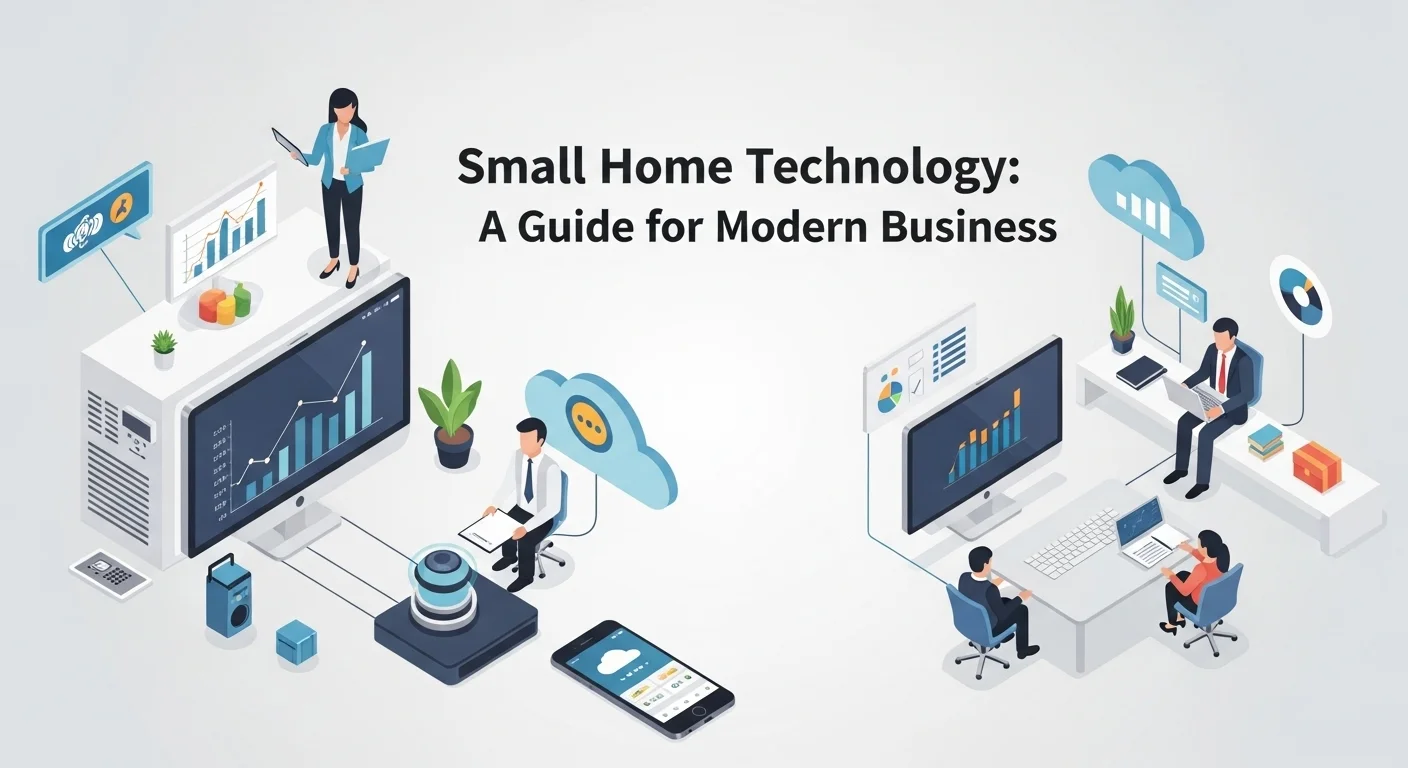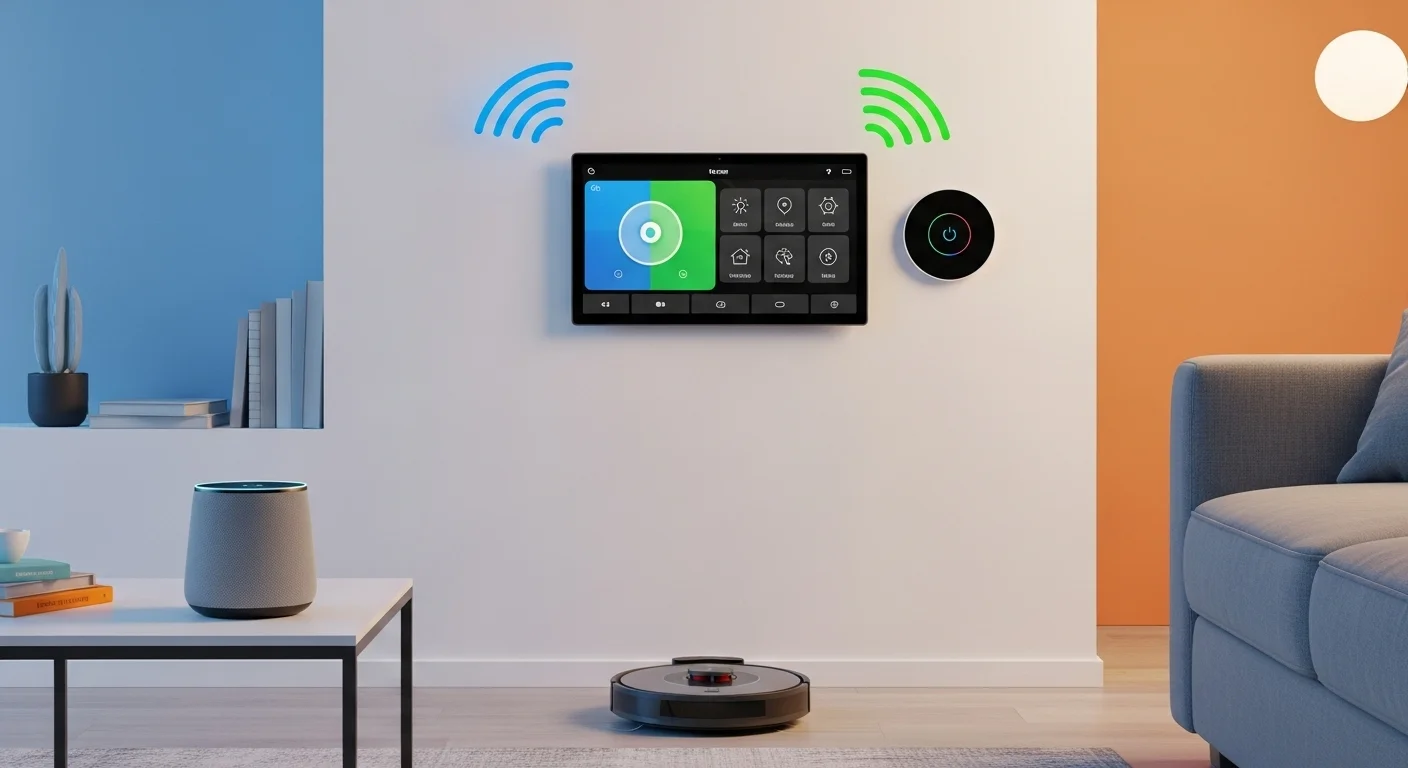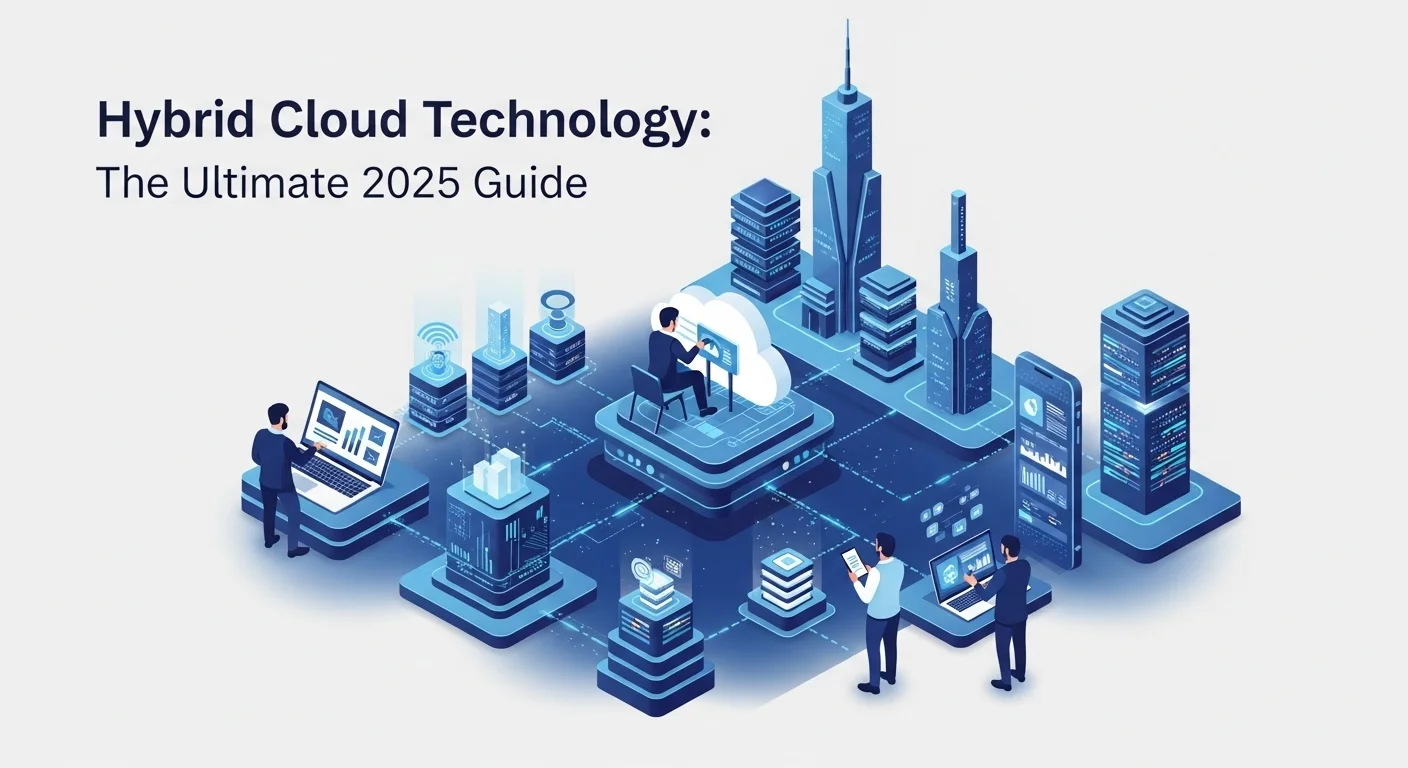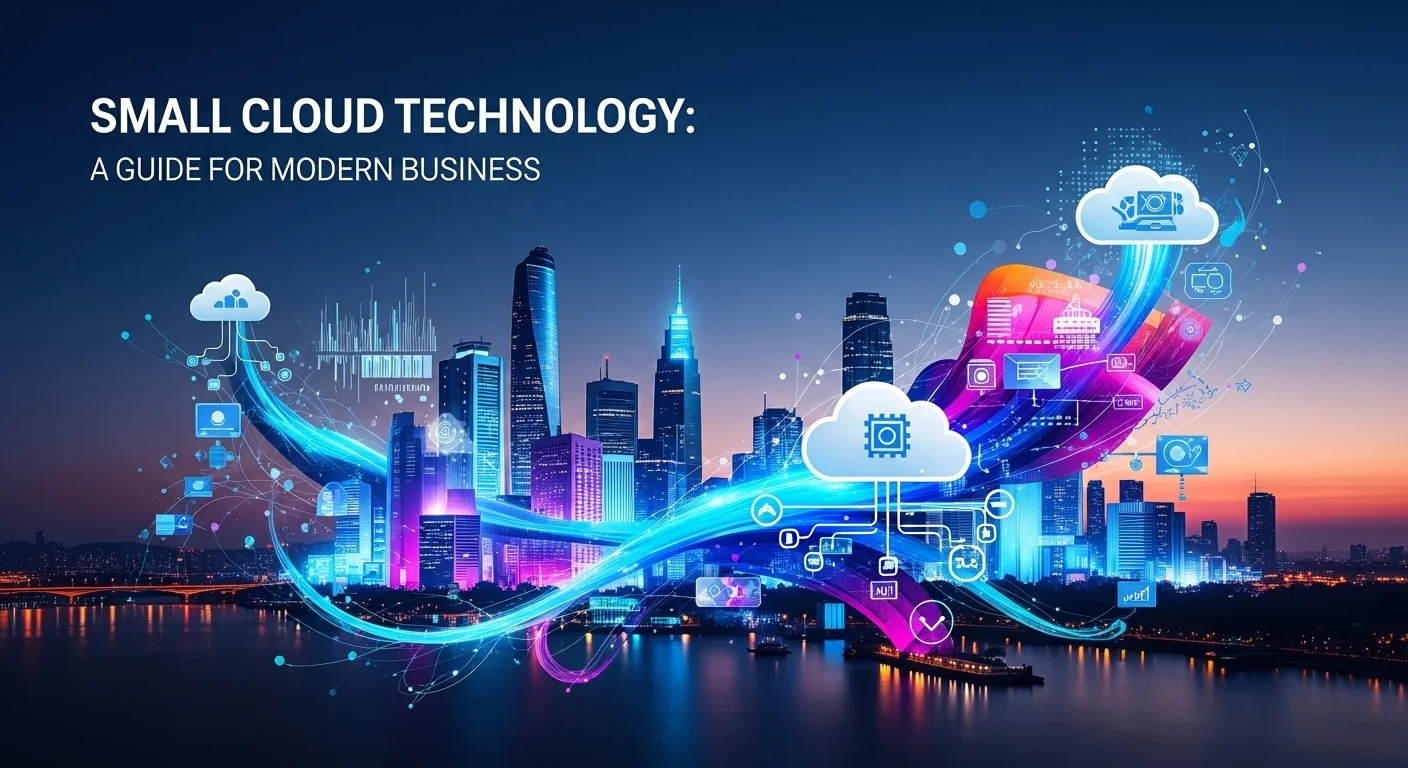The Smart Home Office: Your Ultimate Guide to Building a Powerful Home Business

Executive Summary
Over the last decade, I've seen the concept of 'working from home' evolve from a simple desk in a spare room into something incredibly powerful. We're talking about 'Small Home Technology'—the art of weaving smart, secure, and efficient tech into the very fabric of your home to create a high-performance business hub. This isn't just about cool gadgets; it's a strategic shift that's leveling the playing field for entrepreneurs. In this guide, I'm going to walk you through my personal playbook. We'll cover everything from building a rock-solid, secure network to leveraging AI and cloud tools that give you the power of a large corporation, right from your kitchen table. My goal is to show you how to turn your home into your greatest business asset, boosting your productivity, protecting your valuable data, and unlocking growth you never thought possible.
Table of Contents
Table of Contents
- What is Small Home Technology, Really?
- Why This Tech is a Game-Changer for Entrepreneurs
- Real-World Business Applications and Benefits
- The New Business Paradigm: Your Home as a Launchpad
- A Complete Guide to Your Smart Home Business Setup
- Building Your Bedrock: Networking and Connectivity
- Protecting Your Castle: Cybersecurity Essentials
- Your Virtual Office: Cloud Computing and SaaS
- Your Secret Weapon: AI and Automation
- Making Your Home Work for You: Smart Automation
- Pro Tips to Master Your Small Home Tech
- Daily Habits for Iron-Clad Cybersecurity
- Optimizing Your Day with Automation and Routines
- My Must-Have Business and Tech Tools
- The Final Piece: A Mindset for Success
What is Small Home Technology, Really?
Let's clear things up. When I talk about 'Small Home' technology, I'm not talking about tiny houses. In my world, it refers to creating an intelligent, connected ecosystem within your home that's optimized for both living and professional work. It's the difference between just having a smart speaker and having a home that works for you. Think of it as your personal command center. It's built on a foundation of fast, secure internet and layered with smart automation, the Internet of Things (IoT), and powerful digital services. With so many of us working remotely or launching our own ventures, this concept has become mission-critical. I've seen it firsthand with my clients; a well-designed Small Home setup isn't a luxury anymore. It's the engine that powers a modern home-based business, turning a residence into a competitive, efficient, and secure base of operations.
So, what are the pieces of this puzzle? At its core is a bulletproof network. This means high-speed internet and a modern router that can handle the load. From there, we add layers. Home automation is huge—smart lighting that helps you focus, climate control for comfort, and even automated blinds. I have my lights set to a cool white during work hours to boost my concentration, then they automatically switch to a warm, relaxing tone in the evening. It’s a small change that has a massive impact on my productivity and well-being. Then you have AI assistants like Alexa or Google Assistant. I use mine as a central hub to control devices, manage my calendar, and get quick info, which saves me countless little interruptions throughout the day. For any entrepreneur juggling a dozen tasks, this level of seamless control is a lifesaver.
Why This Tech is a Game-Changer for Entrepreneurs
For entrepreneurs, a Small Home setup is a massive strategic advantage. It gives you a professional-grade office without the crippling overhead of rent and utilities. I've worked with countless startups where this was the key to their survival in the early days. The tech infrastructure directly fuels your business. Reliable, high-speed internet is non-negotiable for client video calls and accessing cloud files. But the real game-changer is security. As a business owner, you are the chief of security. Protecting client data is your responsibility. That’s why a Small Home must be secure by design, using tools like VPNs, firewalls, and encrypted storage. In my experience, showing clients you take security seriously builds immense trust and sets you apart from the competition.
Beyond security, it's about reclaiming your time. The automation built into a Small Home gives you back hours in your week. Imagine a 'start workday' routine: your coffee maker starts brewing, your office lights turn on to the perfect brightness, and your computer boots up with all your essential apps ready to go. This isn't futuristic; it's available right now. This kind of automated efficiency removes friction and lets you dive straight into meaningful work. It allows you to focus your energy on innovation and growth instead of the mundane tasks of just getting started for the day. That efficiency and professionalism is a critical edge in today's crowded market.
Real-World Business Applications and Benefits
The practical uses are endless. I have a client who is a consultant; her Small Home setup ensures her client calls are secure and her data is protected. Another client is a YouTuber; she uses automated lighting and sound-dampening tech to create a perfect recording studio with the push of a button. For an e-commerce seller, it’s an integrated system for managing inventory and customer service right from their home office. The technology that makes this possible is more accessible than ever. Cloud services, for example, let a home-based business use enterprise-level software on a simple subscription model. No need to buy expensive servers. This ability to scale up as your business grows, without massive upfront costs, is a monumental advantage.
But let's talk about a benefit that's often overlooked: work-life balance. When your office is always just a few feet away, it can be hard to switch off. I use my tech to create clear boundaries. An 'end of day' routine powers down my work monitors and computer, and the lighting in the room changes. It’s a simple but powerful psychological cue that says, 'The workday is over.' This is especially vital for entrepreneurs who are often juggling family and business responsibilities under the same roof. Technology can provide the structure needed to protect your personal time and mental health, making a home-based business not just viable, but sustainable for the long haul.
The New Business Paradigm: Your Home as a Launchpad
We're living through a fundamental shift. The blend of affordable, powerful tech and the move towards flexible work has made the Small Home the new frontier for business. It's a great equalizer, allowing anyone with a great idea to launch a company with less risk and more agility. The barrier to entry has been lowered dramatically because the need for a physical office is disappearing. This has created a wave of opportunities, from freelance creatives to boutique online shops, all powered by the robust tech backbone of a Small Home.
And it's only getting better. AI and IoT are becoming smarter and more predictive. We're heading towards a future where your home office anticipates your needs, automatically adjusting lighting, temperature, and even ambient sound to keep you in a state of flow. AI tools that were once exclusive to giant corporations—for market analysis, customer management, and content creation—can now be integrated into your home setup. This isn't just a trend; it's a technological revolution. By embracing it, you're not just investing in gadgets; you're investing in the future success and resilience of your business.

A Complete Guide to Your Smart Home Business Setup
Alright, let's get our hands dirty. Building a high-tech Small Home for your business is about making smart, strategic choices. It's about piecing together the right components so the whole system works in harmony. This is my practical guide to the tech, techniques, and resources you need to build a secure and powerful command center for your home-based venture. Think of this as your blueprint for success.
Building Your Bedrock: Networking and Connectivity
Everything starts with your network. If your internet connection is flaky, nothing else matters. Here’s how I advise my clients to build a rock-solid foundation:
- Invest in Great Internet: Get the best internet service you can in your area. Fiber-optic is the dream, with equal upload and download speeds perfect for video calls and large file transfers. I often recommend a business-class plan; it might cost a bit more, but the reliability and faster support are worth their weight in gold.
- Upgrade Your Router: The free router from your ISP is rarely up to the task. I recommend upgrading to a modern Wi-Fi 6 or Wi-Fi 7 router. They handle more devices without slowing down and have features like Quality of Service (QoS), which lets you tell your network to prioritize your work computer over Netflix. For larger homes, a mesh Wi-Fi system is a must to kill any dead zones.
- Segment Your Network: This is a non-negotiable security step. Think of it like having separate, locked doors in your digital house. Your router should let you create separate Wi-Fi networks. I always set up at least three: one strictly for business devices, one for personal/family use, and a third for all those less-secure smart home gadgets. This way, if a hacker gets into your smart toaster, they can't access your sensitive business files.
Protecting Your Castle: Cybersecurity Essentials
When you work from home, you are the IT department. A security breach can be devastating. Here’s how to build your defenses:
- Firewall On: Your router has a firewall—make sure it's turned on and configured properly. For those handling highly sensitive data, a dedicated hardware firewall is a smart investment.
- Use a VPN: A Virtual Private Network (VPN) is your personal invisibility cloak online. It encrypts your internet connection, making it unreadable to snoops. It's essential when you're handling client information or, heaven forbid, using public Wi-Fi.
- Endpoint Security: Every single device that touches your business network—laptops, phones, tablets—needs top-notch antivirus and anti-malware software. Keep it updated religiously.
- Passwords and MFA: Be a tyrant about passwords. Make them long, complex, and unique for every single account. A password manager is your best friend here. And please, enable Multi-Factor Authentication (MFA) everywhere you can. That little code sent to your phone is one of the single most effective ways to stop hackers in their tracks.
Your Virtual Office: Cloud Computing and SaaS
The cloud is the great equalizer. It gives a solo entrepreneur the same firepower as a major corporation. It's the engine of the modern home business.
- Software as a Service (SaaS): This is where you rent, not buy, your software. My must-haves include:
- Office Suites: Google Workspace or Microsoft 365 are the standards for a reason. They offer professional email, collaboration tools, and cloud storage all in one.
- Accounting Software: Tools like QuickBooks Online or Xero make managing money almost painless.
- Project Management: Asana or Trello are fantastic for keeping your projects and client work organized.
- CRM: A Customer Relationship Management tool like HubSpot's free CRM is invaluable for tracking leads and managing client communications.
- Advanced Cloud Services (IaaS/PaaS): For my tech-heavy clients, like software developers, services from Amazon (AWS) or Microsoft (Azure) provide virtual servers and development platforms that scale with their needs. You only pay for what you use.
- Bomb-Proof Backups: Cloud storage like Dropbox is great for sharing files, but it's not a true backup. I insist my clients use a dedicated service like Backblaze. It automatically back ups your entire computer to the cloud, protecting you from hardware failure, ransomware, or that dreaded 'oops, I deleted everything' moment.
Your Secret Weapon: AI and Automation
AI isn't science fiction anymore; it's your personal assistant, researcher, and copywriter. It's a superpower for efficiency.
- AI Writing Assistants: Tools like ChatGPT or Grammarly are fantastic for drafting emails, brainstorming marketing ideas, or just making sure you sound polished and professional.
- Automation Platforms: Services like Zapier or Make are magic. They connect all your different apps and automate tasks without you writing a single line of code. For example, you can create a 'zap' that automatically adds a new website lead to your CRM and sends you a Slack notification.
- AI for Marketing: There are AI tools that can analyze your marketing data, tell you what’s working, and help you target your ads more effectively. It's like having a data scientist on your team.
Making Your Home Work for You: Smart Automation
Your smart home devices can do more than just play music. Put them to work for your business.
- Smart Lighting: I use Philips Hue bulbs to create different 'scenes.' I have a 'Focus Mode' with bright, cool light for deep work, and a 'Video Call Mode' with flattering, even light that makes me look professional on camera.
- Smart Plugs: These are simple but brilliant. I have my monitors, printer, and other gear plugged into them. My 'End of Day' routine shuts them all down, saving power and giving me a clear signal to log off.
- Smart Security: A smart doorbell lets me see and talk to the delivery guy without breaking my workflow. If I needed to, I could use a smart lock to grant temporary access to a client or collaborator. It’s about seamless security and professionalism.
By layering these technologies—networking, security, cloud, AI, and automation—you build an integrated system that becomes a powerful engine for your business, giving you the tools to compete and win.

Pro Tips to Master Your Small Home Tech
Okay, you've got the gear. Now let's talk about making it all sing. Having the technology is one thing; using it strategically is what separates the amateurs from the pros. These are the tips and best practices I share with my clients to help them truly optimize their Small Home setup. This is how you sharpen the saw, refine your workflow, and build a business that is not only successful but sustainable.
Daily Habits for Iron-Clad Cybersecurity
Good security is a habit, not a product you buy. In my experience, complacency is the single biggest risk to a home business. Make these practices second nature.
- Update, Update, Update: This is the simplest and most critical habit. Turn on automatic updates for everything: your computer's OS, your web browser, your apps. Hackers love to exploit old, unpatched software. Don't leave the door open for them.
- Encrypt Your Data: Turn on the built-in disk encryption on your computers (BitLocker on Windows, FileVault on Mac). If your laptop gets stolen, this makes the data on it unreadable garbage. It's a simple switch to flip for incredible peace of mind.
- Be Skeptical of Emails: Phishing attacks are getting scarily sophisticated. Train yourself to be suspicious of any email that creates urgency or asks for passwords. Always double-check the sender's address and hover over links to see where they really go before you click. A healthy dose of paranoia is a good thing.
- Dispose of Data Securely: When you get rid of an old computer or hard drive, don't just delete the files. Use a proper disk-wiping utility to securely erase the data. For paper, a cross-cut shredder is your friend.
- Have a 'What If' Plan: Spend 15 minutes thinking about what you would do if you got hacked. Who would you call? What passwords would you change first? Having a simple checklist ready can turn a full-blown panic into a manageable incident.
Optimizing Your Day with Automation and Routines
Technology should work for you, not create more work. Use it to build routines that protect your focus and energy.
- Become a Virtual Assistant Power User: Go beyond setting timers. Create custom routines. I have a 'Focus Mode' routine on my Google Assistant. It silences my phone, starts a focus playlist, and lets my family know not to disturb me via a smart display. My 'End Workday' routine does the reverse, creating that crucial mental separation.
- Explore IFTTT or Zapier: Dive into services like 'If This, Then That' (IFTTT). You can create powerful little 'recipes' that connect your digital life. For example: 'IF a new file is added to my client's Dropbox folder, THEN create a task for me in Asana.'
- Automate Your Social Media Presence: You have to be online, but you don't have to live there. Use a tool like Buffer or Hootsuite to schedule a week's worth of posts in one sitting. This keeps your brand active without constantly pulling you away from your real work.
- Tame Your Inbox: Your inbox is not your to-do list. Be ruthless with filters and rules. I have rules that automatically file away receipts, newsletters, and notifications, keeping my main inbox reserved for messages that actually require my attention.
My Must-Have Business and Tech Tools
Investing in a few key pieces of equipment can have an outsized impact on your professionalism and well-being.
- A Good Webcam and Microphone: Let's be honest, your laptop's built-in camera and mic are terrible. A dedicated 1080p webcam and a quality USB microphone are a small investment that makes you look and sound 100% more professional on client calls.
- Ergonomics Matter: You're going to be at this desk for hours. Don't destroy your body. A good ergonomic chair is non-negotiable. A standing desk and an ergonomic mouse can also be life-changers, preventing pain and boosting energy.
- Network Attached Storage (NAS): For those who want total control over their data, a NAS device like one from Synology is like having your own private cloud. It's a central hub for all your files and backups. I love mine.
- Uninterruptible Power Supply (UPS): This is a battery backup for your most important gear. If the power flickers, a UPS gives your computer and router enough juice to save your work and shut down safely. It's saved me from losing work more times than I can count.
The Final Piece: A Mindset for Success
Finally, the most critical element isn't a piece of tech; it's your mindset. Running a business from home takes immense discipline and a commitment to always be learning. View technology as your partner. Set aside a little time each month to review what's working and explore new tools. Stay curious. The incredible thing about a Small Home business is its agility. You can adapt and change on a dime. By combining the right tech with smart habits and a growth mindset, you can build a business that is not only profitable but also deeply fulfilling.
Expert Reviews & Testimonials
Sarah Johnson, Business Owner ⭐⭐⭐⭐
A really solid overview. As an Etsy seller, I'd have loved a few more specific case studies for different business types, but the core advice on security and automation is spot on. Very helpful!
Mike Chen, IT Consultant ⭐⭐⭐⭐
As an IT guy, I was impressed. The article didn't just talk about fun gadgets; it focused on critical topics like network segmentation and endpoint security, which are often missed. A practical, valuable guide.
Emma Davis, Tech Expert ⭐⭐⭐⭐⭐
This is the article I'm sending to all my friends starting their own businesses! It perfectly explains how to build a professional tech foundation at home without being overwhelming. The section on creating routines with AI was a game-changer for me.



